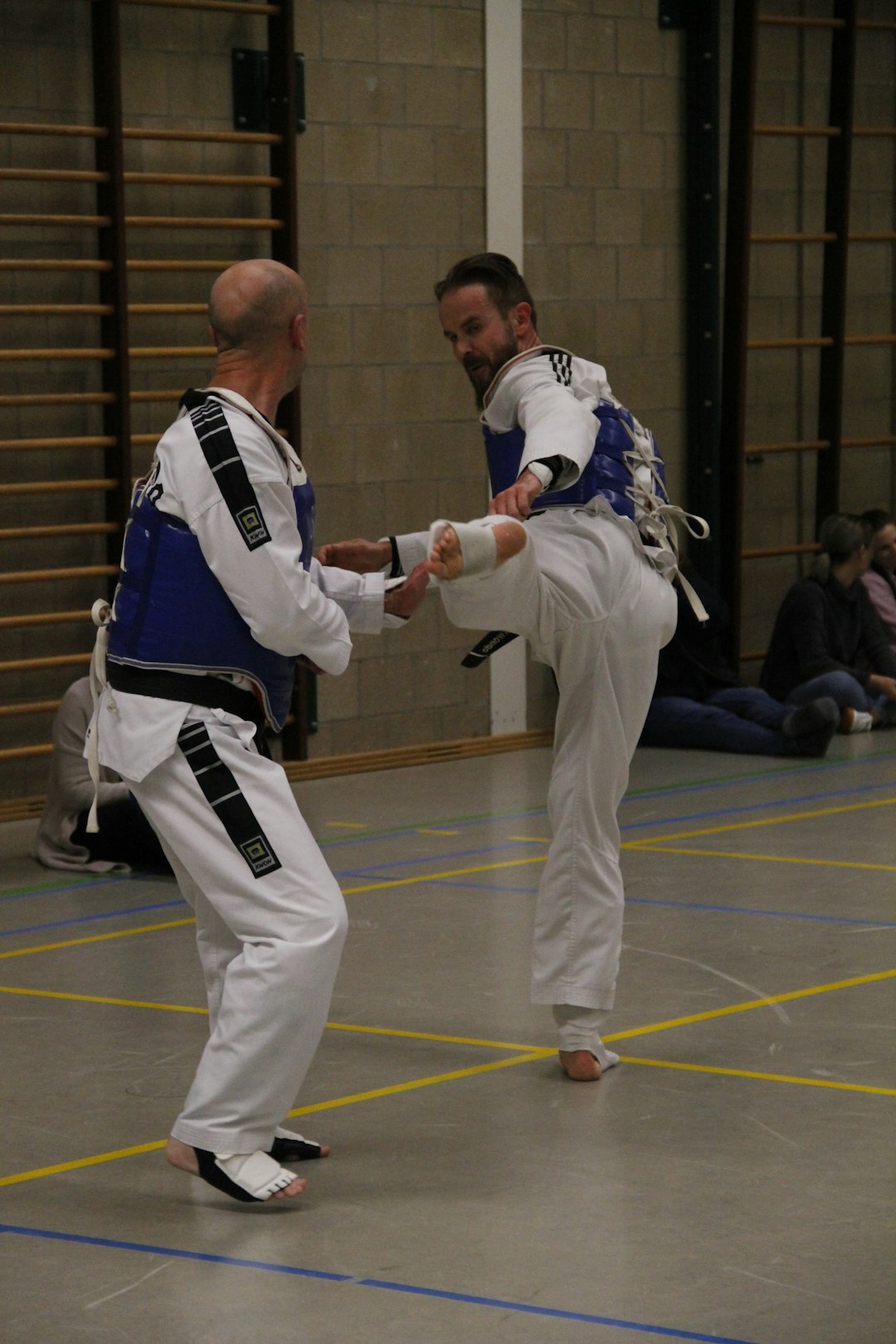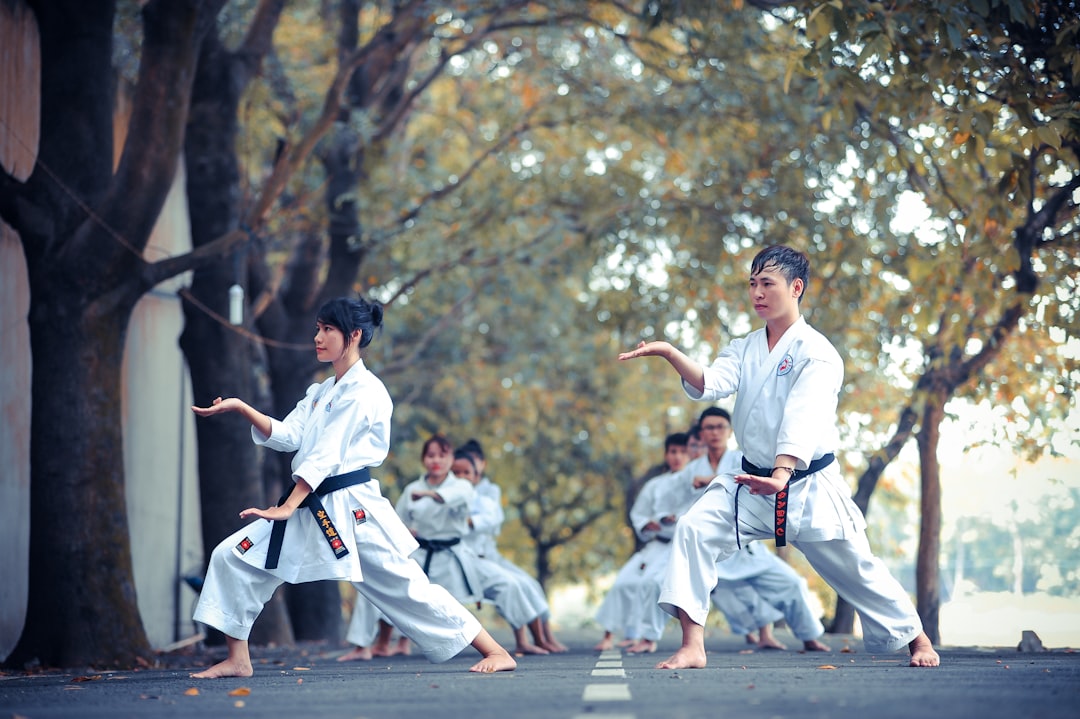The traditional karate uniform, known as a "keikogi," is a specialized garment consisting of a jacket called an "uyede," straight-legged trousers named "are-shin-gi," and a belt referred to as an "obi." Its design is purposefully functional and respectful to the art, with each component carefully chosen to facilitate movement and indicate the practitioner's rank. The keikogi represents not just the practical aspect of karate but also symbolically reflects the wearer's proficiency in the discipline. Understanding the correct terminology for the karate suit is crucial for both maintaining traditional values and ensuring practical application. The section clarifies that the term "Gi," often used interchangeably with keikogi, has its roots in Okinawan attire and has been influenced by Japanese judo, specifically in its term "Keikogi." Over time, the Gi has evolved to become more standardized while still honoring karate's heritage. When choosing a karate suit, or as it's commonly known, a karate uniform name, one must consider the material's quality and grip, fit for optimal movement, and color that signifies rank and affiliation. The right karate uniform name will enhance performance and comfort during training, reflect personal style, and align with karate's traditions.
When stepping onto the karate mat, the attire worn by practitioners is more than mere clothing—it’s a symbol of discipline and respect. But what do you call this essential garment, and where does its designation originate? This article peels back the layers to explore “karate uniform name,” delving into its historical evolution, anatomical structure, and the nuances involved in selecting your ideal karate suit. Join us as we navigate “The Anatomy of a Karate Uniform” and trace the etymology behind this martial arts staple in “Historical Evolution: The Etymology Behind Karate Gi Terminology.” Whether you’re an experienced martial artist or a newcomer to the dojo, understanding “karate uniform name” is key to honoring tradition and embracing the essence of the practice.
- Unraveling the Essentials: The Anatomy of a Karate Uniform
- Historical Evolution: The Etymology Behind Karate Gi Terminology
- Choosing Your Gear: Factors to Consider When Selecting a Karate Suit
Unraveling the Essentials: The Anatomy of a Karate Uniform

When practicing the disciplined art of karate, donning the appropriate attire is crucial; but have you ever pondered what the uniform is precisely called? A karate uniform, often referred to as a “keikogi” in Japanese, is a essential component of traditional karate practice. This garment, crafted for both functionality and respect for the martial art, typically features a jacket, trousers, and a belt, each element designed to facilitate movement while signifying the wearer’s rank. The top, known as the “uyede,” is a jacket that reaches just below the waist, fastened with buttons running down the front. It allows for ease of motion during practice. The trousers, called “are-shin-gi,” are straight-legged and secured at the waist by ties or elastic. They are designed to remain in place during rigorous exercises and sparring sessions. The belt, or “obi,” though not a part of the uniform itself, is integral as it indicates the wearer’s level of proficiency within the discipline. Is it clear now what the karate suit is officially named? A keikogi is the term used to describe this traditional training garb in karate. The design and fabric of the keikogi are chosen to provide comfort, durability, and a consistent fit, ensuring that the practitioner can concentrate on perfecting their techniques rather than being hindered by their attire.
Historical Evolution: The Etymology Behind Karate Gi Terminology

The term “karate uniform” commonly refers to what practitioners wear during training and competitions, known as a “Gi.” The Gi’s origins can be traced back to ancient Okinawa, where its predecessors were simpler in design. Over time, the traditional Gi has evolved, influenced by Japanese judo attire, to become the standardized garment recognized today. The word “Gi” itself is derived from the Japanese term “Keikogi,” which literally translates to “training clothes.” It is composed of a jacket and trousers, traditionally made of cotton or hemp, with specific designs that reflect both functionality and respect for the martial art.
What distinguishes the Gi used in karate from those in other martial arts is its relatively lightweight fabric and its simpler, less padded design. The evolution of the Gi in karate has been a response to the needs of the practitioners, as well as cultural exchanges and adaptations that have occurred over the centuries. Are the modern Karate Gis significantly different from their historical counterparts? Yes, they have been modified to be more standardized in cut and material, providing comfort and facilitating movement for the athlete. This evolution reflects both the changing nature of karate as a sport and the influence of globalization on traditional practices.
Choosing Your Gear: Factors to Consider When Selecting a Karate Suit

When embarking on the journey to select a karate suit, also known as a karate uniform, it’s crucial to consider several key factors to ensure optimal performance and comfort during training. Firstly, material is a significant aspect; you should evaluate the weave, weight, and durability of different fabrics. Does the fabric offer enough grip for effective technique execution? Is it breathable to keep you cool and dry during intense workouts? These are essential questions that will guide your choice. The ideal karate uniform name for a beginner might differ from one designed for advanced practitioners, as the demands on the suit can vary significantly with experience.
Another important factor is fit. A well-fitted karate suit should allow for a full range of motion without being overly restrictive. It should not be too tight, hindering your movements, nor too loose, causing the uniform to bunch or ride up during practice. Consider how the suit feels during various stances and motions; this will help you determine if it’s the right fit for you. Additionally, the color of the karate suit can signify rank and affiliation with a particular dojo or style of karate. Ensure that the karate uniform name aligns with your training requirements and personal preferences while adhering to the standards of your martial arts community.
In conclusion, the karate suit, commonly known as a ‘keikogi’ or practice uniform, serves as both a traditional and functional garment for practitioners of this martial art. Its origins and evolution provide insight into the discipline’s rich history, while selecting the appropriate keikogi is essential for comfort, performance, and respect for the practice. Understanding the essential components of a karate uniform, as detailed in “Unraveling the Essentials: The Anatomy of a Karate Uniform,” coupled with historical context from “Historical Evolution: The Etymology Behind Karate Gi Terminology,” equips enthusiasts with the knowledge to choose their gear wisely, as outlined in “Choosing Your Gear: Factors to Consider When Selecting a Karate Suit.” Whether you are an experienced martial artist or a newcomer to the dojo, comprehending the significance of a karate uniform’s name and its role is key to honoring this time-honored tradition.
